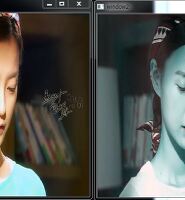백인감자
파이썬 OpenCV motion detection _ 검출 영역 이미지 저장 본문
이슈사항
배경이 되는 frame update 가 안되는 코드라서 유동적으로 배경 frame 을 바꿔 줄 필요성이 있을 것 같다.
ex. 밝기의 변화, 첫 frame 에 사람이 찍히는 경우 등을 대비.
특히 밝기 변화에 너무 민감해서 불필요한 이미지가 저장된다.
frame :카메라에서 받아들이는 원본 영상
firstframe : background 영상, 카메라가 켜진 후 첫 번째 frame 이다.
gray : frame 에 grayscale 후 가우시안 필터 적용한 영상.
frameDelta : firstframe 과 gray 의 absdiff 를 적용한 영상.
thresh : frameDelta 를 이진화 한 영상. 여기서 findcontours 함수 사용하여 윤곽선 검출하고 객체 이미지 저장.
BackgroundSubstractorKNN 을 기존코드에 응용해봤는데 모션 검출이 정확히 이루어지지 않는다.(frame 전체를 잡음)
Background Substraction 종류별 비교 영상
종류별 코드 구현 예시 : http://docs.opencv.org/3.0-beta/doc/py_tutorials/py_video/py_bg_subtraction/py_bg_subtraction.html
검출 영역 이미지 저장
출처 : http://www.pyimagesearch.com/2015/05/25/basic-motion-detection-and-tracking-with-python-and-opencv/
위 출처에서 잘 만들어 놓은 예제에서 detecting 된 이미지들을 저장하는 방식으로 수정을 하였다.
출처코드 line 56~57에서 에러가 발생하여
(_, cnts, _) = cv2.findContours(thresh.copy(), cv2.RETR_EXTERNAL,
cv2.CHAIN_APPROX_SIMPLE) 로 수정하였다.(OpenCV 3.0 부터는 이 코드를 사용해야 한다고 한다.)
영상을 찍었을 때 첫 번째 frame 자체를 배경으로 인식하기 때문에 사람이 찍히지 않는 상태여야지 좀 더 정확한 결과가 나올 것이다.
영향을 주는 요소들은 다음과 같다.
fps -->videoCapture 객체의 set 함수를 통해 조절 가능
영상의 width, height --> cv2.resize() 함수를 통해 조절 가능
detecting 의 최소 픽셀 크기 (default = 500)
argument 설명
터미널 혹은 cmd 에서 python -m 파이썬코드.py -v 동영상이름 으로 하면 저장된 동영상에 대해서 motion detect 수행
ex. python -m 파이썬코드.py -a 8000 를 하면 검출하는 모션의 픽셀크기가 최소 8000 이다.
참고 : 파이썬에서 경로 설정시 \ 대신 / 로 바꿔줘야 한다.
저장되는 이미지가 많기 때문에 frame번호_각 frame 당 count 된 영역 개수 와 같은 형식으로
1프레임에 4번째 검출된 영역이면 frame1_4.jpg 와 같은 형태로 저장하였다.
cs
detecting 영역 크기를 2500픽셀로 설정, fps 15 , 640 * 480 으로 설정하고 객체이미지 저장을 조절하기 위해 3 frame 당 한 번씩 움직이는 객체에 대한 저장을 수행하였다.
촬영한 영상에 대한 결과는 아래와 같다.
저장된 움직이는 객체 이미지 목록은 다음과 같다.
'OpenCV' 카테고리의 다른 글
| 영상 이진화 (0) | 2017.07.24 |
|---|---|
| 파이썬 2.7 , 3.x 버전 함께 사용 & OpenCV 환경구축 (0) | 2017.07.20 |
| [OpenCV 3.0]watershed 함수 (0) | 2016.08.12 |
| [OpenCV 3.0]RGB 채널 이동시키기 (0) | 2016.08.11 |
| [OpenCV 3.0]동영상에서 edge 추출하기 (0) | 2016.08.08 |




